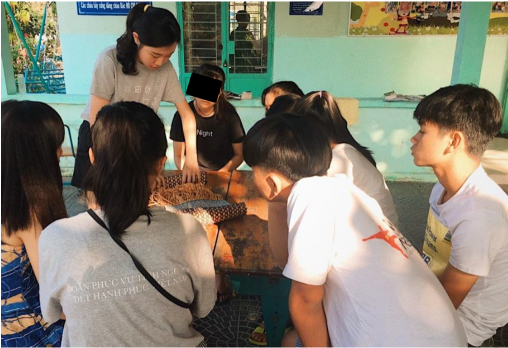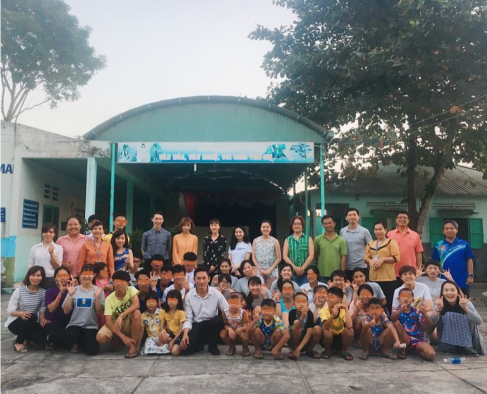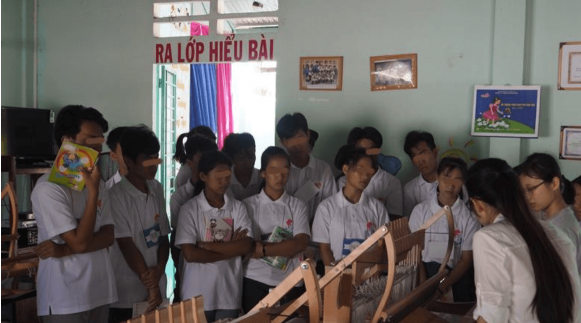


- Origin of the plan The textile and clothing businesses are a basic and essential part of the everyday life-related industry in emerging countries; development of the businesses is a necessary step for emerging countries to transition from agricultural to industrial societies. Many such countries, at the beginning of economic development, engage in light industry, which requires a large population. Accordingly, Vietnam has particularly demonstrated itself to be strongly competitive because of its generally young population; compared with other Southeast Asian countries, Vietnam has undergone rapid economic development. During the rush of overseas investment, Taiwanese manufacturers took advantage of the opportunity in the form of a bilateral trade relationship. Through this relationship, Vietnam has become a major production base for Taiwan’s textile and clothing industry. In 2018, Taiwan was Vietnam’s fifth largest trading partner, and Taiwanese investment in Vietnam accounted for 35.5% of investment in the Association of Southeast Asian Nations (ASEAN). In Vietnam, Taiwanese businessmen, employing more than 500,000 local workers, are the largest locally based foreign employers. Vietnam is the epitome of Taiwanese business in the ASEAN.
- Chanh Phu Hoa Orphanage in Binh Duong, Vietnam Chanh Phu Hoa Orphanage is located in a sparsely populated and extremely remote area of rubber plants, approximately 60 km north of and a two-hour drive from Ho Chi Minh City. The orphanage, located in the Bến Cát town of Bình Dương Province in Vietnam, is 10 km from My Phuoc Industrial Park, where Taiwanese businesses are concentrated. The details of the orphanage’s geographic location are presented in Figs. 1, 2, and 3. The orphanage is affiliated with the Chanh Phu Hoa Social Protection Centre, which is a government social welfare management organization. The Chanh Phu Hoa centre currently accommodates more than 800 individuals requiring government-assisted living and the orphanage houses 50 orphans aged ≤18 years or minors whose parents cannot take care of them. Preschool children at the orphanage receive early childhood education from full-time educators. School-aged children receive compulsory education at neighbouring primary and secondary schools. Adolescents attend senior high schools located farther from the orphanage. Chanh Phu Hoa Orphanage struggles to raise funds for tuition fees every semester. The first visit to the orphanage in early 2017 revealed that the majority of the children (i.e., more than 15) were aged ≥12 years; most orphans are adopted at a young age by people from Europe and North America and rarely stay until adulthood. Learners of weaving techniques must have a minimum level of understanding and learning capacity. Therefore, the volunteer team first investigated orphanage and children’s interests in textile weaving; they received positive responses. Chanh Phu Hoa Orphanage was thus selected as the volunteer service base where the machinery and equipment would be installed. Thus, the FJCU textile service team was formed to implement a long-term service plan involving learning, creating, weaving, and developing marketing plans for textile goods.
- Past volunteer sessions (first to fourth sessions) The FJCU textile service team comprises volunteers specialised in textiles and clothing. The team has devoted extensive time and effort in the form of the design and development of apparel, the teaching of manufacturing, and the establishment of marketing channels to support Chanh Phu Hoa Orphanage, an orphanage located in a rural area of Vietnam that lacks resources. The team proposed to provide the school with a source of income by teaching the orphan children weaving skills, cultivating favourable attitudes towards life and work, and building teamwork skills while also building the children’s confidence, understanding of aesthetics, and creativity. The FJCU textile service team is the first task-oriented team composed entirely of students from the FJCU Department of Textiles and Clothing. The team was registered at FJCU in May 2017, and the first division of volunteers was dispatched on July 23, 2017, soon after registration.
- The first volunteer session occurred over 8 days (July 23–July 30, 2017) and included six FJCU students and two FJCU professors. Of the six students, four were sophomores from the Textile Design group. These students were trained to act as the seed members for the second volunteer session. The equipment required for the program, five wooden manual shuttle looms and two warping frames (made in New Zealand), were purchased and donated by Taiwanese businessmen in Vietnam. The first session of the program involved basic design and creation exercises, instruction in aesthetic awareness, establishment of a theoretical foundation, and hands-on practice for 15 older orphan residents (aged 12–18 years). The children learned how to sew basic stitches, warping, drawing-in, and beating-up. The children attended the lessons with great passion, and they learned the techniques quickly; they became eager to experiment and apply their own innovative ideas. The main focus of the first volunteer session was installing equipment, introducing children to the program, and teaching basic weaving techniques.
- (2) The second volunteer session occurred during the volunteer students’ winter vacation. The session lasted for 15 days (January 20–February 3, 2018) and included 12 students and three professors. The content of instruction was mainly weave derivatives, self-designing and manufacturing yarns using environmentally friendly materials, and product making. The three manual spinning machines, five reeds, approximately 240 kg of paper yarn, and transport services required for this session were generously provided by Huge Bamboo Enterprise and Far Long Industrial. Of the 19 student applicants for the program, eight were recruited as volunteers for the second volunteer session. These volunteers were chosen based on their service enthusiasm, relevant volunteer experience, professionalism, and personality traits. The total service team comprised 12 members, and each member was assigned a different task. Eight members were in the Textile Design group and were assigned the roles of team leader, deputy team leader, and curriculum and instruction division leader and were responsible for administrative management, teaching activities, and activity planning, respectively. The remaining four students were in the Fashion Marketing group and received professional training on basic weaving techniques. These students were responsible for product planning and marketing planning. Products would be marketed in Taiwan with the intention of later potentially expanding marketing overseas. The three professors were respectively responsible for instruction in weaving techniques and product planning, marketing products, and administrative guidance. The entire team spent nearly 2 days exploring and developing an understanding of the current state of development of the hipster, cultural, and creative commodity markets in Ho Chi Minh City as a reference for future program development.
- The third volunteer session spanned over 15 days (June 30–July 14, 2018) and included 12 students and two professors. Of the 12 students, eight were in the Textile Design group and were responsible for teaching, developing lesson plans, and administrative planning. The remaining four students were in the Fashion Marketing group and were responsible for photography, artistic design, public relations, and developing marketing plans. Because members who had participated in the second volunteer session were still unfamiliar with course instruction, the team members for the third session completed basic professional training and were then provided with opportunities for practical application. Subsequently, the students were assigned teaching roles according to their strengths. The seven members who had already participated and the five new members of the volunteer program were trained to become future seed members and pass down their experience. The two professors were respectively responsible for instruction in weaving techniques, discussions with student volunteers, administration, and plan advising.
- The fourth volunteer session occurred over 15 days (January 15–January 29, 2019) and included eight students and two professors. No new members were recruited in the fourth session due to time restraints; providing training in professional weaving to new members over a short period would have been unproductive, and the supervisors or teachers would not have effectively been able to assist the residents of the orphanage. Moreover, the team planned to organise a creative achievement exhibition in Ho Chi Minh City in the fifth session, which would require experienced members for operation and discussion to run smoothly. After excluding the fourth-year students, who were preparing for their own graduation exhibitions, a total of eight members, all of whom had experience in previse sessions (1–3 sessions) were selected. The division of labour in the team was based on each member’s strengths. Three students were assigned to the Textile Design group and were responsible for teaching, developing lesson plans, and administrative planning. The remaining five students were in the Fashion Marketing group and were responsible for photography, artistic design, public relations, and developing marketing plans. Because basic operations had been taught in the preceding three sessions, the courses in the fourth session mainly focused on the exhibition that was to occur in the fifth session. The courses in the fourth session involved postprocessing fabrics, tassel changes, ironing fabrics, and the final touches of goods.
- Most current volunteer session (the fifth volunteer session)
The most current session occurred over 15 days (June 30–July 14, 2019) and included 13 students and two professors. Of the 19 students who applied to participate, five were recruited as new volunteers, which added five new members to the existing eight from (a total of 15 members). After the team members were selected, the new members received comprehensive professional training and the existing members prepared for the upcoming session by reviewing the unfinished tasks from the fourth session, identifying potential problems facing the residents of the orphanage in subsequent sessions, and developing lesson plans for the courses that would occur before the exhibition. After the new members finished their training, they were divided into three groups—(A) Weaving, (B) Yarn Braiding, and (C) Spinning Balls—which were also the three themes of the exhibition; the new members were to jointly design courses for the time leading up to the exhibition. Basic preparation for the exhibition, including confirmation of the number of products made by the residents of the orphanage, confirming product quality requirements, and postprocessing of fabrics, had been completed in the fourth session. Therefore, the current session focused on the exhibition itself, which involved final work revision, creating art labels, and exhibition installation. The upcoming exhibition not only inspired more diversified lesson plans but taught the children of the orphanage how to end an exhibition and how to store their woven goods. - 2020 course content The course focused on “preparation and holding of exhibitions” as the main theme; course content involved defect repair, exhibition planning, installation of the exhibition, and creating records for goods. A series of relevant courses were arranged according to the schedule and the situation of the residents of the orphanage. Daily review meetings were held to revise the course schedule.
Responding to the long-term investment of Taiwan’s textile and clothing industry in Vietnam and the effects of the Trans-Pacific Partnership, the Department of Textiles and Clothing at Fu Jen Catholic University (FJCU) began a program in which students participate in summer internships at Taiwan’s Vietnamese production bases; this program has yielded favourable results since 2007; accordingly, the university has cooperated with Taiwan’s businessmen in the textile and clothing industry based in Vietnam to satisfy the talent requirements of relevant design and marketing. At the end of 2016, Professor Yu Cheng-ping from the FJCU Department of Textiles and Clothing discussed corporate social responsibility with Taiwanese businessmen, and in early 2017, the department visited Vietnam and discovered Binh Duong, the province north of Ho Chi Minh City, to contain many orphanages. A senior Japanese volunteer, who was a teacher of textile weaving, left textile products to be sold at the orphanages and returned to Japan. However, the sales results were not satisfactory. At FJCU, the Department of Textiles and Clothing is separated into three divisions: fashion design, textile design, and fashion marketing. These categories constitute the middle- and downstream supply chain of the textile and clothing industry. To improve sales performance in Binh Duong, the FJCU Department of Textiles and Clothing initiated a plan to create its first ever overseas volunteer team. This plan would use the range of the department to implement supply chain management involving product design and planning, product manufacturing, and marketing. Professor Tsai Li-ju, who specialises in textile design, was invited to join the team to provide design and technology guidance with the intention of enabling volunteer team members to overcome limitations to contribute to the international community during their professional studies, cultivate soft skills, and develop core competency. Both professors and students in the FJCU Department of Textiles & Clothing intended to commit themselves to this volunteer service plan long-term. In the initial stage, two divisions of volunteers were dispatched annually to teach the orphans textile weaving and braiding and thereby cultivate their problem solving, teamwork, aesthetic awareness, and confidence. The volunteer team further hoped designing and developing valuable textile goods that would earn profits to assist the orphans in obtaining sufficient educational resources and eventually establish a social enterprise.